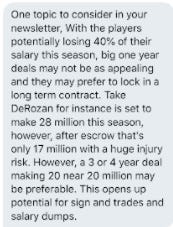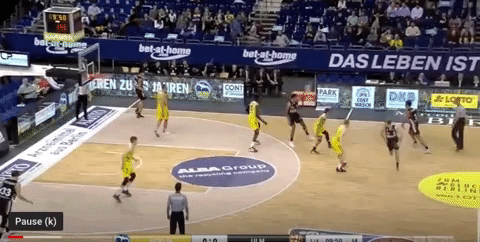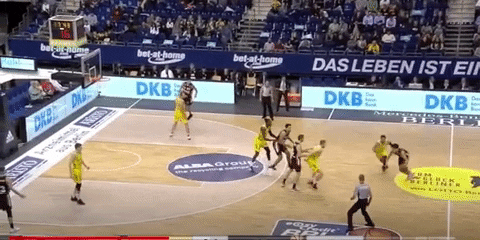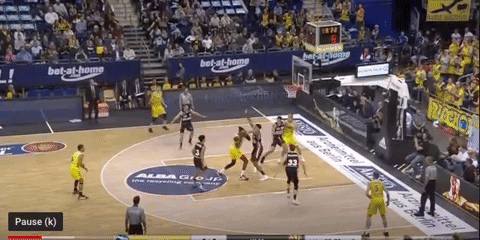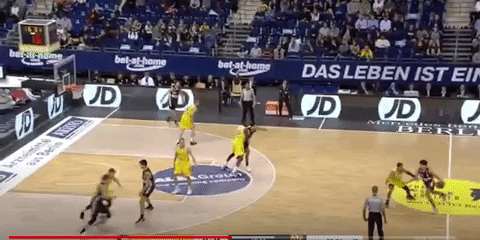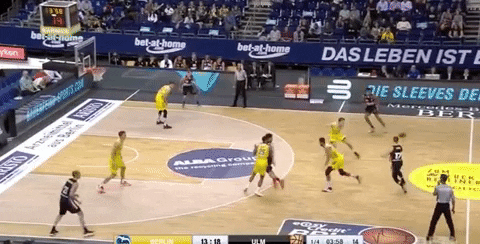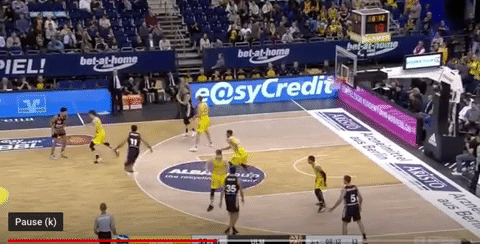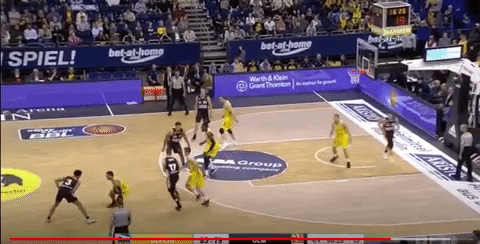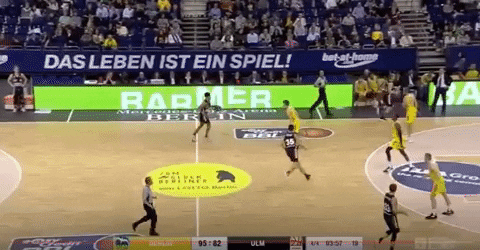Killian' Time
Need a distraction? Me too. Let's look at some tape on a kid who might be the point guard answer the Knicks have been seeking for almost 50 years.
News & Notes
The fate of the universe is still up for grabs, as we all woke up rooting for the Bucks, Pistons, Sixers, and those plucky, out-of-nowhere Hawks.
(Well, if you went to sleep, that is.)
Several Knicks got out and voted yesterday, including Bobby Portis, Elfrid Payton, Dennis Smith Jr and first-time-voter Kevin Knox (he’s only 21!). Former Knick Allan Houston also cast a ballot.
There is still much to be decided where the NBA’s restart is concerned, but it seems that we’re headed for a December 22 start after all, or at least that’s my read on the situation. According to Shams, how much player salary goes in escrow is also still at issue (the players want 15 percent, the owners 25, and 18 has been mentioned as a compromise point).
The Player’s Association will vote on a restart date tomorrow. If they approve December 22, there will be 14 back-to-back games per team, but also a 25 percent reduction in travel. Lastly, the NBA is pushing for a flat cap of $109 million for several years, which could further benefit teams like the Knicks that are in a more liquid position, cap-wise.
In other news, there seems to be momentum for a play-in tournament featuring the 7 through 10 seeds in each conference moving forward.
Ian Begley reported that one team he spoke with assumes Christian Wood will be a top Knicks target this offseason, seemingly based off of how much they scouted him last season. It’s important to keep in mind, however, that Leon Rose hadn’t even assembled his front office or basketball ops staff when the season shut down, so New York’s thinking may have changed since then.
Speaking of Rose, Marc Stein reports that he is making $8 million a year.
Quick: someone tell him that the special to get this newsletter for $3 a month or $30 a year expires on Friday. $8 mil doesn’t go nearly as far as it used to.
According to The Ringer’s Kevin O’Connor, Boston has offered a package including all three of it first-round picks (14, 26 and 30) to try and move up in the draft. No word on how high they’re seeking to go though.
Support Your Independent Content Producers!
Stacy Patten of the Strickland had a nice writeup on potential second rounder Immanuel Quickley. Reminder that the Knicks are now Kentucky North, so this is probably worth your time.
Ask Macri
Thanks to Twitter user Jason Meredith for this one, which I have been thinking about for a few days, and even more so with the report about the owner’s desire to keep the cap flat for several years into the future.
My first thought when I read this was “well, if players are only going to be making a little more than half of their stated salaries for this season, wouldn’t that incentivize some guys to want one-year balloon deals that get them the number they would have been making in a normal year?”
For example, if Joe Harris now needs to make $20 or 25 million on the books next year to get the $15 million he always thought he’d be earning, might that incentivize him to see out that number? I spotlight Harris’ case because, as Shwin wrote about last month, a $15 million contract could cost the nets over $60 million in tax payments because of their cap situation. $20 or $25 million would be quite a bit more.
With a flat cap also possibly in play for several years now, it’s even easier to see teams with bloated payrolls being awfully conservative with the long-term deals they hand out. The same should be true of the Knicks, because as a team without any long-term salary obligations, staying liquid might become their best asset.
So yes, I think there’s a chance this leads to shorter deals. On the flip side, long term security may be an even greater priority for some players depending on their situation. Take Christian Wood. Aside from the fact that he may not be as good as he showed in a meaningless small sample size last season, Wood has made bupkis in his NBA career. For him, locking in long term money may be an even greater priority because he stands to make less than the contract reads next season.
As for the sorts of salary dumps and sign & trades the whole cap/escrow situation might bring forth, I think that depends more on the owners taste for shelling out dough in such uncertain times. That probably changes depending on which team you’re talking about.
Killian Time
With news that the Celtics could be down for trading up, it brought me back to the single greatest draft pondering I’ve had this offseason: if Killian is there at 8, should the Knicks look a gift horse in the mouth or just do the easy thing?
There’s so much that goes into the answer, primarily who the team trading up wants to target. If Boston wants, say, Onyeka Okongwu, and you bypass Killian to take Okongwu with the assumption that Kira Lewis will be there at 14, but Phoenix snatches up Hayes and someone else takes Lewis before you pick, what then? My assumption is that New York wouldn’t leave such a thing to chance, but that would mean being equally comfortable with a bevy of options at 14 (or wherever they’ve dealt down to) or simply being OK with the player they bypassed Killian for.
Ultimately though, this comes down to their opinion of Hayes. If the NBA has taught us nothing over the years, it’s that when a talent is special enough, it doesn’t matter what someone else is offering. You take the guy and don’t look back.
Is Killian that level of player? If you check the interwebs for things folks have said about him over the last several months, you’d certainly think so:
He’s “German league James Harden” and “all the physical tools are present and he's got the kind of innate offensive IQ that you simply can't teach” - NBA.com
“Modern point guard who can not only run the pick and roll and make all the passes but he can get his own shot off the dribble and is becoming a threat from 3pt land” - NBADraftRoom.com
“Hayes has a tremendous basketball IQ. When it comes to his ability to read a defense out of ball-screens and pick out the right pass, he’s elite. He can find shooters on the weak side of the floor. He can throw pocket passes to rolling bigs. He can attack switches, and he has shown the ability to be a three-level scorer off the bounce.” - NBCSports.com
“In a league where perimeter shooting, playmaking, and defensive versatility are at a premium, Hayes is my top-ranked prospect in this year’s class.” - Kevin O’Connor, TheRinger.com
“He has every pass in the book off of a live dribble. He’ll hit cross-corner kickouts with either hand, throw terrific little pocket passes, and has just about perfect touch on lobs. Genuinely, as a pick-and-roll passer, I think Hayes and LaMelo Ball are in a class unto themselves in this draft.” - Sam Vecenie, The Athletic
All of this praise has probably made the last several weeks confusing for Knicks fans, because it has been rumored that Killian Hayes is falling in the draft.
Kevin O’Conner reported last week that he could see Hayes falling to the mid-late lottery, and Vecinie wrote a few weeks back that Hayes is “all over the board for evaluators across the league, from a few having him in the top-five to a few having him just outside of the lottery. ” Meanwhile, Bleacher Report’s draft sage Jonathan Wasserman has repeatedly stated that teams simply aren’t anywhere near as high on Hayes as Draft Twitter thinks they should be. Add it all up, and it seems like the Knicks aren’t even a sure bet to take advantage of their good fortune should he fall.
As I reported several months back, the Knicks like Killian. That much I know. Then two weeks ago, Marc Berman reported that according to an NBA source, Hayes “currently has a narrow edge as the team’s second point guard on the board after LaMelo Ball.”
This is no doubt encouraging, but “narrow edge” is a far cry from “we’re taking him if he’s there,” which is what a lot of fans feel the front office’s stance should be. With the opportunity to trade down for a serious haul (and possibly still being in a position to grab another top target) possibly on the table, there’s now a real scenario where the Knicks have a chance to take Killian…and don’t.
How big a mistake might that be? Let’s take a closer look.
I went back and watched both of Hayes’ efforts against Alba Berlin, the team that wound up winning a post-COVID, closed doors tournament to determine the Basketball Bundesliga champion.
The very first offensive possession of the game for Ulm (the fairly mediocre squad Hayes played for last year) shows the gift and the curse that he presents. Knowing that Killian has absolutely no right hand - the most glaring defect in his game, if not the most troubling one - there was a brief attempt at a trap, which forced Hayes to back out towards half court. This, obviously, is not ideal.
However, the 18-year-old goes right back on the attack again, drawing the help defender away from the corner long enough for his teammate to get a relatively open look.
The right hand isn’t the only thing likely scaring teams off.
Hayes lack of athleticism has been well documented, with the counter being that his combination of IQ, touch, vision, passing ability, and flat out old-man craft is enough to make up for it. He does indeed have all of that in spades.
And yet, as we see in this second clip, he’s still susceptible to getting jammed up on what should have at least turned into a trip to the line. The help defender did a nice job positioning himself for the contest and going vertical, but the fact that Hayes could miss a shot like this is a tad concerning.
Yes, Hayes usually has really nice touch, around the rim and everywhere, but if he was scared to deploy that touch on a regular basis against the likes of Hans and Franz, how will NBA defenders alter his approach? It may be unfair to draw a conclusion based on games played entirely at the age of 18, but the concern is certainly not unwarranted.
Here, we see the aforementioned touch, but again, there’s as much to be concerned about with this play as there is to be excited for.
For one, the lack of confidence in his right hand forced him to avoid the easiest path to the hoop, thus delaying his progress ever so slightly and giving the center time to get back in the play. Hayes’ shot isn’t altered here, but an NBA defender sends that into the third row.
Second, and somewhat related, is the shying away from contact. Hayes is a damn good free throw shooter - 87.6 percent last season - but because he got there so little, it hardly mattered. Hayes free throw attempt rate was a paltry .313, as he got to the line less than four times per 36 minutes.
When you couple in the lack of attempts at the rim with the inability (or unwillingness) to get to the line, you begin to wonder what his ceiling is as a lead guard in the NBA. And there’s more:
The lack of a right hand rears its ugly head yet again.
At a certain point - maybe we’re already there, with Hayes failing to solidify himself as a top-ten pick in a fluid draft - you can no longer say “the right hand will come.” If he was showing enough other stuff to give you confidence that, were this issue to continue, it wouldn’t seriously compromise his ability to score effectively inside the arc, you’d be quicker to forgive it.
But early on last season, that didn’t appear to be the case. When a big doofy German can stand up straight 15 feet from the basket and stop your drive like a brick wall…it’s not great.
But enough of the bad stuff for a bit. I didn’t come here just to bury Ceasar, only to put him in perspective. By and large, Hayes is a ticklishly exciting prospect, with good reason to be second on my (and many’s) board for a while now:
*chef’s kiss*
There are a lot of reasons to fall in love with Killian Hayes, several of which I went through earlier. He also has nearly ideal positional size, has shown enough on defense to make you feel like he won’t be a minus even if he might not be a plus, and the Harden-vibe step-backs speak for themselves.
But you draft Killian for the passes. They’re pretty, they’re purposeful, and they’re precise.
I mean, look at this baby:
Aside from the few concerning plays I highlighted above, Killian positively dominated every inch of the court over the first two and a half quarters of this game, and he did it almost exclusively with his passing.
He was hitting his spots and putting every one on the money. There was nothing cheap about a single one of his 11 dimes; every one was earned. It was the type of performance that makes you feel like that one skill alone will be enough to make him a plus player at the next level, almost regardless of how the rest of his game progresses.
As a result, Ulm hung tight with a superior opponent for most of this game. Better still, Hayes showed you a few glimpses of a burgeoning part of his game: the floater.
Hayes didn’t take many of these - he had a little more than one attempt per game from the close midrange - but he had a few in this one that were encouraging.
(The obvious question is whether this can ever rise to a passable level of efficiency to be a weapon as opposed to a novelty. You can count the NBA players on one hand who have floaters that opponents genuinely fear. Maybe Hayes can add his name to the list, but we have a long way to go before that point).
But this was one of the last positive plays Hayes made on the night. When he re-entered the game in the fourth quarter, Berlin turned the screws, repeatedly daring him to go right. The results were less than encouraging.
This turnover came after a string of possessions where Hayes was completely stymied by the defense. They took all his tricks and savvy and completely neutralized them.
Early on in this game, Killian was measured in responding to traps - which Berlin halfheartedly threw at him on occasion - and remained poised in staying on the attack. That aggressiveness vanished late, replaced by the unsteady hand that you’d expect to see in an 18-year-old playing against a top opponent. Hayes didn’t shoot, committed a ghastly offensive foul, coughed up the ball a few times, and generally looked overmatched.
This play was the last straw:
After that, his coach pulled him, probably afraid he’d add to the eight turnovers he’d already accumulated in just under 31 minutes. The game was all but decided anyway. There was no use rubbing salt in the wound.
Overall, this game showed a lot of both the good and bad when it comes to the draft’s fifth youngest prospect. All things considered, it wasn’t a bad performance by any means (it was, after all, just his 11th game of the season and second playing more than 30 minutes). But if this was the only game you got to see, it left more than a few unanswered questions.
Tomorrow, I’ll break down Hayes’ follow up effort against the same opponent from a little over three months later. I’ll not only be comparing the two games, but also positing Hayes against his contemporaries in this draft, and try to figure out whether there should there be any hesitation whatsoever if Hayes is there at 8.
See you tomorrow.
Don’t forget, only two newsletters left before I limit freebies to once-per-week and eventually biweekly. There’s still time to lock in a forever rate of $3 a month or $30 for the year right here (check Monday’s newsletter if you have no idea what I’m talking about).
Thanks again for reading! #BlackLivesMatter #CountTheVotes




